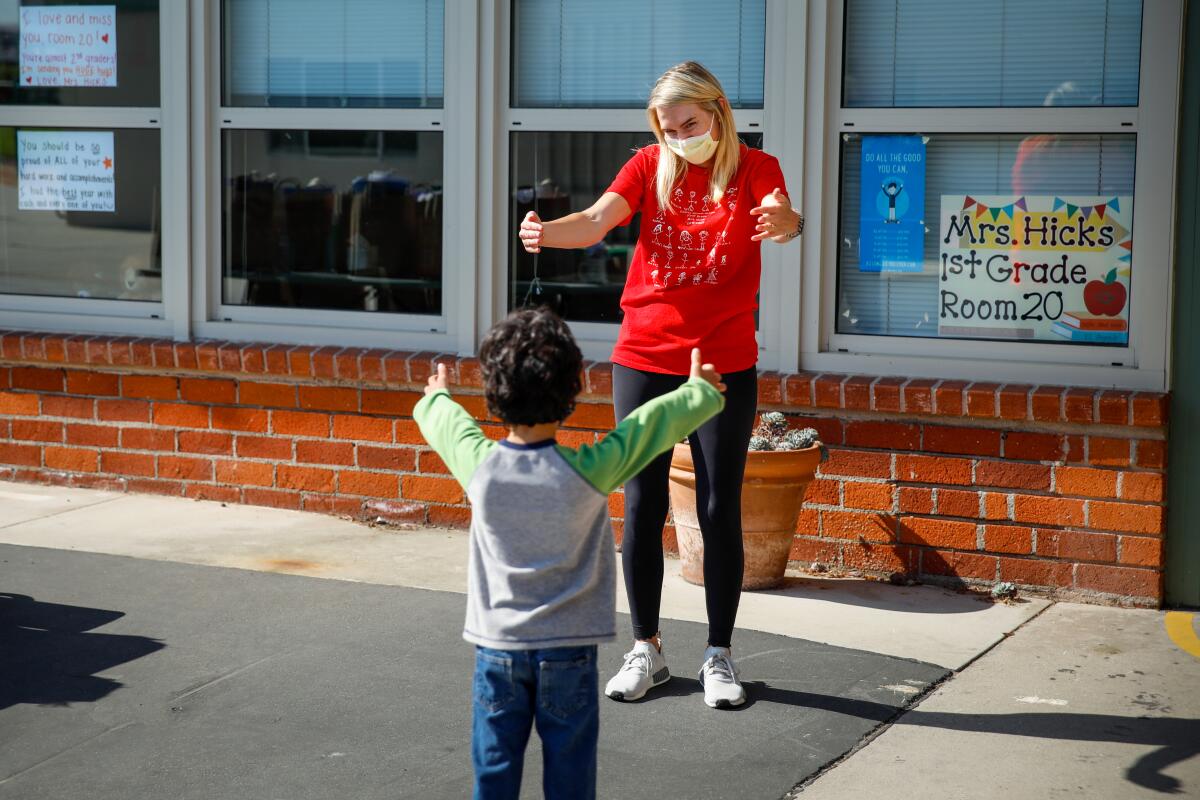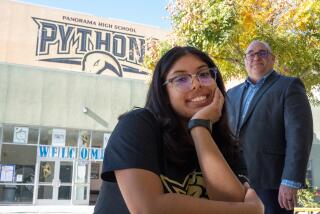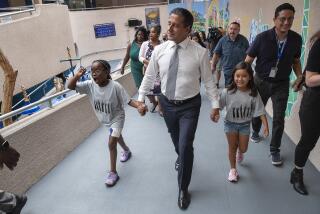Online or in the classroom, teachers and students must show up every day, new rules say

- Share via
When it comes to education, the new state budget goes beyond providing $70.5 billion in funding for K-12 schools — it sets fundamental accountability rules for a new era of distance learning in California by requiring teachers to take online attendance and document student learning.
The budget bill, which Gov. Gavin Newsom is expected to sign, anticipates that schools will continue to rely heavily on online instruction when campuses reopen in the fall. It also implicitly acknowledges the deep learning losses of the last semester, especially among students from low-income families, when school systems struggled to get all students online.
The new directives establish minimum teaching parameters for distance learning while protecting teachers against immediate layoffs.
“Educators and teacher unions have won fairly steady funding from Sacramento to reopen schools this fall,” said UC Berkeley education professor Bruce Fuller. “Now the imperative is to deliver a rich blend of online and face-to-face instruction.”
Fuller said the emphasis on documentation reflects concern by state leaders that “tens of thousands of kids simply unplugged in the spring, then fell further behind.”
Whether schooling is online or in person, the rules reimpose the state’s minimum daily instructional minutes requirement of 180 for kindergarten, 230 minutes for grades 1 through 3, and 240 minutes for grades 4 through 12. Distance learning can be documented with student work as well as time online.
Schools also must develop procedures for reengaging students absent from distance learning for more than three school days in a school week. Schools are allowed to develop alternate plans, with input from parents, for achieving these mandates when necessary.
When the pandemic forced campuses to close in March for the remainder of the school year, the state told educators to continue teaching by any form necessary and possible — and schools statewide scrambled to distribute computers, internet hot spots and hastily assembled paper packets.
Recognizing this burden, state officials set aside fundamental and familiar rules such as taking attendance and providing a requisite number of minutes of teaching each day. School district leaders and charter school operators frequently followed suit — emphasizing compassion over rigor and recognizing that schooling could not simply be switched instantly and seamlessly from a face-to-face classroom experience to face time over a screen.
There’s also been concern that some teachers simply were unable to get up to speed with online learning that required quick acquisition of new skills, leaving a void in daily instruction.
A survey of parents by a local advocacy group found significant levels of dissatisfaction with the amount of instruction offered in the Los Angeles Unified School District after campuses closed.
Parents reported that 40% of their children received live instruction daily and 1 in 3 students had interactive contact with a teacher once a week or less, according to Speak Up. Moreover, Black and Latino students were up to three times more likely than white students to have participated in live classes once a week or less.
Also, Black and Latino students were up to seven times more likely than white students to have never interacted with teachers. English learners and students with disabilities also received less interaction with teachers, according to responding parents.
“It’s unacceptable that the kids that need the most help received the least amount of instruction this spring,” said Katie Braude, Speak Up’s chief executive.
The group surveyed its contact list of about 4,000 parents across the district, receiving more than 400 responses. While not a scientific sample, the survey encompassed geographic and ethnic diversity, although white families were overrepresented and Latinos, who are 3 of every 4 district students, were underrepresented. The survey was conducted June 10 to 24, at the end of the school year.
Parents in the survey and in an online news conference Friday overwhelmingly cited health and safety as their top concern, but they also prioritized improvements in the quality and quantity of online instruction.
While recognizing shortcomings, L.A. schools Supt. Austin Beutner has repeatedly praised district teachers and staff for doing so much right so quickly, especially given the unknowns attached to distance learning.
“It’s not reasonable for students or educators, nor is it sound educational practice, for teachers and students to spend six hours a day in online, two-way communication,” Beutner said in late March. “And families who are struggling to get by in this crisis may not be able to spend all day trying to help their children do schoolwork.”
San Pedro High School English teacher Maya Suzuki Daniels found a need for flexibility on both the teaching and learning side during the last semester. Students wanted live video sessions but were more likely to join them in the evenings because of jobs or siblings to care for. Others fared better with a video they could pause and rewind. In addition, Suzuki Daniels and her husband had to juggle their own work as well as care for their son Silas, who is approaching his first birthday.
“The four-hour workday that UTLA negotiated was absolutely essential,” said Suzuki Daniels, who loves teaching. “I thought I was going to have to quit.”
A flexible work schedule is likely to remain crucial for her, she said.
The new rules are expected to address the uneven learning and attendance problems of the last semester, especially now that school systems have had several months to develop distance learning, said Assemblywoman Christy Smith (D-Santa Clarita).
“We wanted to make sure that we establish a bare minimum standard that we are backing up with resources,” Smith said. “We know how costly this is going to be for districts to rise to this challenge.”
Assemblyman Patrick O’Donnell (D-Long Beach) said he had persistent concerns that school districts may need more flexibility than the new rules allow.
In the overnight rush to establish online learning, the largest charter school group in L.A., Alliance College-Ready Schools, did not require live, interactive teaching and did not mandate a specific number of working hours for teachers. But administrators estimated that teachers would need about 18 to 30 hours a week to do what was minimally necessary.
“We could not ask teachers and kids to log in at 10 a.m.,” said Nathalie Benoit, Alliance’s vice president for marketing and communications. “Teachers also have kids at home. And we don’t know what the situation is at home for students.”
Alliance did take a form of daily attendance by asking students to respond every day to questions about their emotional well-being and whether they needed help.
Anthony Martinez, superintendent of Montebello Unified, said that his district, like many, didn’t take attendance after mid-March. Students, he said, were in crisis and many lacked the computers or internet access that would allow them to do assigned work, he said.
“It was important to reach out to our students on a ‘How are you doing?’ level, versus attendance and classwork,” he said.
L.A. Unified brokered a deal with the teachers union that specified 20 hours of teacher work time per week.
It wasn’t enough, said Speak Up’s Braude: “We have to set much stronger minimum standards for daily live online instruction this fall. Three hours a day should be the bare minimum.”
Parent Elizabeth Gomez said her seventh-grade son with Down syndrome received no instruction at all this spring. His teacher at an L.A. Unified middle school attempted only one live video class, and then gave up. And her son’s district-provided speech therapist left one voicemail with no return number or email.
She acknowledged that teaching students with limited verbal skills is challenging but said more effort should have been undertaken.
“It’s been very frustrating for us,” Gomez said.
Raquel Toscano has two children at Maywood Center for Enriched Studies, which she called “a great school.” Even so, she said, the instruction was uneven.
Sharnell Blevins, a Hamilton High School parent, said the district set expectations too low for teachers and students.
“I hope now that we understand where we are that we’ll actually shoot for excellence,” she said. “What we received in the spring wasn’t enough.”
But Marlowe Jefferson, a rising eighth-grader at Lawrence Middle School in Chatsworth, said her six teachers worked effectively and creatively, even though each teacher used Zoom with her class only about one hour per week.
She can’t wait to get back to campus, but “I think I learned everything I needed to learn,” she said, before heading off to a socially distanced rugby practice.
Times staff writer Sonali Kohli contributed to this report.
More to Read
Sign up for Essential California
The most important California stories and recommendations in your inbox every morning.
You may occasionally receive promotional content from the Los Angeles Times.












